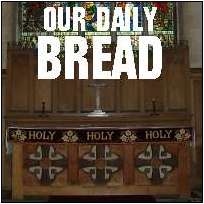
home I index I introductions I e-mail I about this site

12. Our Daily Bread
Some ordinary Norfolk churches
| Every English parish church is
unique: every visit to an English parish church is a
unique event. There is a danger in following the
formulaic guide books, and only seeing what they see when
looking through their eyes. Each visit then becomes a
trail through familiar territory. In reality, each
building is a record of its personal history, the result
of its centuries of buffeting, a visible echo of the long
generations who saw it as the heart of their community.
They are organic, reflective of their place, not merely
conforming to an ideal, each a true original. No English
parish church has ever seen inside another. The long centuries, however, are not guarantors of the future. Just because these buildings have been with us for so long does not mean they will survive forever. For centuries before the Reformation they were sacramental touchstones to the mystical power of the Catholic Church. This became translated after the Reformation, and if they were no longer magical they were still held in awe as homes of communities at worship, as well as the focus of secular power. They were the heart of the parish, which recorded the ordinary man's birth and death, and regulated his life in between. The Victorians tried to reintroduce some of the old medieval magic, and in so doing massively increased church-going in both the parish churches and the non-conformist chapels. Perhaps as much as half the population attended church regularly in the mid-19th century, almost unimaginable today. But this could not last. Today, the Church of England has far too many churches, and many of them are wholly unsuitable for their modern use, especially in winter. In addition, the heritage lobby not unreasonably fights for the survival of the large number of churches of architectural and artistic importance - there are perhaps fifty churches in Norfolk and Suffolk the loss of which would be a tragedy of international significance. But the loss of any medieval church would be a tragedy, if only because it has been a touchstone of one kind or another for so many generations. We have seen the heart go out of villages that have lost their church to redundancy in the last quarter of a century, and it is hard to see a sustainable future for many of those that survive, as congregations age and dwindle. If the mass of ordinary English medieval churches are to survive, then they cannot depend on the needs of the Church of England, or the priorities of heritage groups. No, the key to their survival is the communities themselves, both the immediate residential community, and the wider area which is richer for having these beating hearts scattered throughout it. One district of Norfolk that knows this is Wayland, where the village churches have been central to a European Community-led initiative. They are a focus for tourism, for projects by local school children (absolutely essential this, it gives local young people a stake in their future) and are generally given a high profile. The Wayland Partnership is being studied closely by local authorities elsewhere. Outside of Wayland, of course, Norfolk is full of other parish churches in small towns and villages, and their future must be considered uncertain. They may be in the hearts of those who love them, but bureaucrats in Norwich and London make decisions with their heads, not their hearts. Romantically, Norfolk's sleepy lanes are home to the greatest concentration of medieval buildings in western Europe, but in crude modern terms this means that Norfolk is highly over-resourced, and maintainance needs-heavy. What must be done? Cheap short term solutions or a commitment to more expensive long-term strategies? This introduction links to six ordinary parish churches, past and present. They are all within a few miles of each other in a small area of north Norfolk. They have distinguished neighbours: Cley, Blakeney, Binham and Walsingham are all close at hand. Apart from Holt, they all serve tiny communities. Apart from Bayfield, they are all still working churches in use by the Anglicans; I have included Bayfield, perhaps, as a warning. To all intents and purposes the rest are just ordinary churches. All of them are special, of course, especially to the people who use them, or have used them, or have ancestors who used them. But they are bread and butter churches, typical of hundreds of others, thousands, all over England. Unique as they are, their continued survival is a shared problem, the key to their future a shared solution. Simon Knott, November 2004 click below
to visit the churches Bale Bayfield Field Dalling Glandford Holt Saxlingham home I index I latest I introductions I e-mail I about this site I glossary |